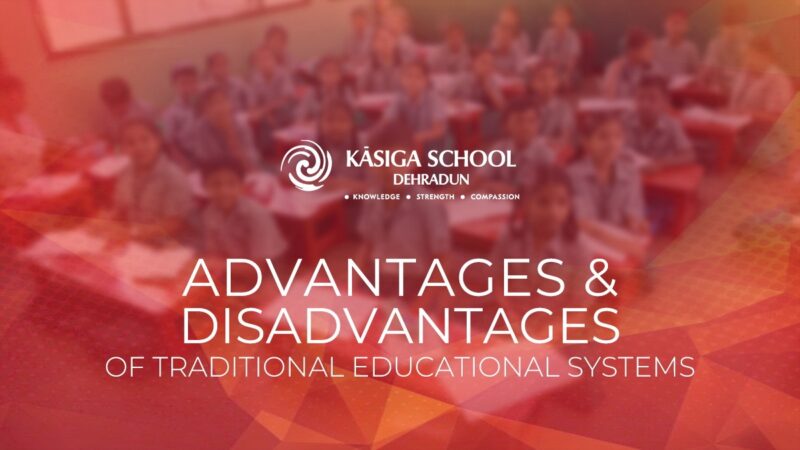Education has always been the pillar of human advancement. From ancient times to the modern era, education has determined how societies work & human beings develop.
With the passage of time, various approaches to teaching have been developed but traditional educational systems have continued to play a major role. For decades, they have formed the core of education, transferring knowledge from generation to generation in an organized & disciplined manner.
Even now, with the advent of technology-based approaches & modern education, traditional teaching still remains important. While offering stability, familiarity & organizational structure, it also has some inherent limitations that have to be addressed in the rapidly changing world.
To better comprehend it, let’s look into the positive & negative aspects of traditional educational systems & how they compare with the norms of the educational system in modern India.
Understanding Traditional Educational Systems
Traditional education is learning that is teacher-led, lecture-based & textbook-reliant. The teacher is the central source of information & students are supposed to listen, remember & understand information. Such a system finds its origin in the ancient education system in India where Gurukuls focused on discipline, respect & face-to-face interaction between teachers & students.
Although times have changed, the nature of traditional education remains the same with organised classes, fixed timings, examinations & a one-way flow of information. While it guarantees discipline, it may not always contribute to creativity or innovation.
Advantages of Traditional Education
• Disciplined & Structured Learning
Perhaps one of the most compelling strengths of traditional teaching is the structure it creates. A fixed schedule, syllabus & clear expectations assist both students & teachers in being organised. This discipline tends to prepare students to take responsibility later on in life.
Other than this
• Students understand what they are doing each day.
• Clear objectives make learning predictable & less disorienting.
• Direct Interaction with Teachers
In traditional classroom settings, students are able to socialise with the teachers in person. It not only facilitates immediate feedback but also instils trust & motivation. Teachers can provide guidance, encouragement & clarification on the spot.
Other than this, it
• Fosters a closer teacher-student relationship.
• Promotes accountability & self-discipline.
• Strong Foundation for Exams
As traditional education is primarily textbook & lecture-based, it goes with exam trends. Students who have been trained under this system tend to do well on standardised tests due to their capacity for memorisation & recall of facts.
Other than this, it
• Assists in preparing students systematically for exams.
• Grants clarity of what should be expected in exams.
• Social Skills & Teamwork
Learning in classrooms also builds social interaction. Students communicate, share & participate in group activities which develop teamwork & interpersonal skills.
Other than this, it
• Encourages healthy competition.
• Helps in personality development.
Disadvantages of Traditional Education
• Lack of Creativity & Innovation
A major drawback of traditional education is that it emphasises rote learning. Students may memorise information without truly understanding it. This limits creativity, problem-solving skills & independent thinking.
Other than this, it
• Emphasise more on “what to learn” than “how to think”.
• Demoralises curiosity & discovery.
• One-Size-Fits-All Approach
Traditional classrooms assume that all learners learn at the same speed & in the same manner. This can prove to be troublesome for students of varying learning styles. Some might be left behind, while others might not be sufficiently challenged.
Other than this, it
• Does not promote individualised learning.
• Slow learners get demotivated.
• Overemphasis on Exams
As traditional education is exam-oriented, pupils study only to get marks & not actual understanding. This can lead to stress & restrain practical knowledge.
Other than this, it
• Fosters short-term memorisation.
• Declines emphasis on skills that matter in actual life.
• Limited Use of Technology
In the rapidly developing digital era, solely depending on books & lectures can prove to be restrictive. Without the aid of modern technology, students might not be equipped for the demands of a technologically oriented workplace.
Other than this, it
• Leaves a gap between academic learning & practical usage.
• Lacks exposure to the modern way of teaching.
Difference Table: Advantages vs Disadvantages
| Advantages of Traditional Education | Disadvantages of Traditional Education |
| Provides structured & disciplined learning | Can suppress creativity & innovation |
| Strong face-to-face teacher-student interaction | Follows a one-size-fits-all approach |
| Prepares students well for exams | Overemphasis on memorisation & marks |
| Builds teamwork & social skills | Limited use of technology & real-world applications |
Balancing Tradition with Modern Education
It is important to remember that the traditional teaching approach is not completely outdated. Its discipline, structure & one-on-one guidance still remain valuable. But how these are merged with modern education techniques such as electronic aids, active learning & project-based learning can make for a more holistic method.
The truth is that the future is in the merging of the old with the new. Schools that bridge technology with traditional systems have better chances of preparing students for academic achievement & real-world challenges. This is what characterises the strength of the education system in modern India today.
Conclusion
Traditional education systems have been the pillars of education for millennia. They have provided us with organised classrooms, strong teacher-student bonds & orderly environments. But they are also accompanied by issues like less innovation, pressure of examinations & no use of technology. The answer does not lie in ditching traditional education but in blending it with modern methodology.
Today, parents & students have to find schools that achieve this equilibrium by providing structure but also facilitating innovation. Schools such as Kasiga have managed to balance the strengths of traditional teaching with the benefits of modern learning. With a focus on complete-person development, we educate children not only for tests but for life itself. This gentle infusion of tradition & modernity means that kids grow up as well-adjusted individuals capable of confronting the future.

